Use the following link to download the July 27, 2024 issue of the syəcəb
Category: Tulalip News
Kids, crafts, and culture

By Wade Sheldon, Tulalip News
Tulalip Lushootseed Camp wrapped up its second week of the play “Little Mink and Younger Cousin Tetyika” on Friday, July 19, at the Kenny Moses Building. This marked the end of another successful camp. Each of the two weeks, the camp welcomed 50 kids, providing both a break for the parents and an opportunity for the youth to fully immerse themselves in the culture and language of their ancestors.

Michele Balagot, Lushootseed department manager for over 15 years, was honored for her decades of service in the department at the Lushootseed Camp. Appreciating her contributions, all her former co-workers and employees gifted her a blanket.
The two witnesses, who observe all the work the children have done to put on the play, are also honored. These two are chosen on the day of the play and brought to the front of the audience to get a full view, and then they speak about the work after it is over. One of the witnesses was tribal member Dean Pablo.
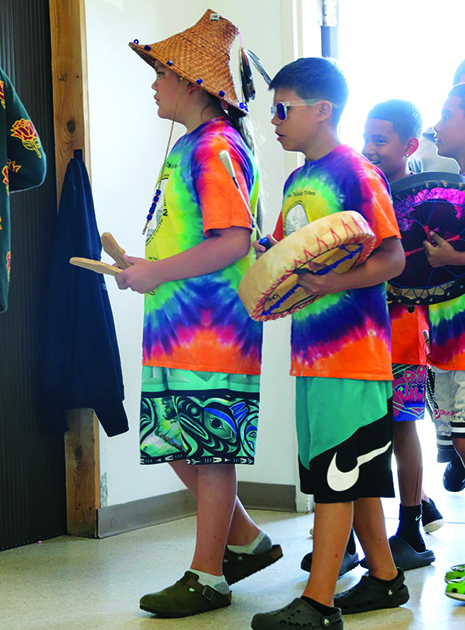
He said, “We want to take the time to honor these kids. There was a time when this language couldn’t be spoken, and now our youngest in the community get to speak it in gatherings, and I think that’s something to be proud of.”
Lushootseed Manager Natosha Gobin added, “Seeing the kids consistently for a week is good. I wish we could keep them for longer. But it seems to be the perfect amount of time for this age group to spend one week with us. They are able to pick up all the teachings, and they have fun doing the crafts. The play will never be perfect, but the kids will always remember it.”

“Camp was fun!” said Eddie, a camp student. “My favorite part was when we got to make the paddles. I made an orange one. I learned that when you bother the whale, he will eat you, and you will learn a lesson.”

Another student, Kamille, enthusiastically confirmed that she had a great time at camp. and particularly enjoyed going to the beach. When asked what she learned during the play, she replied, “I learned to sing songs.”
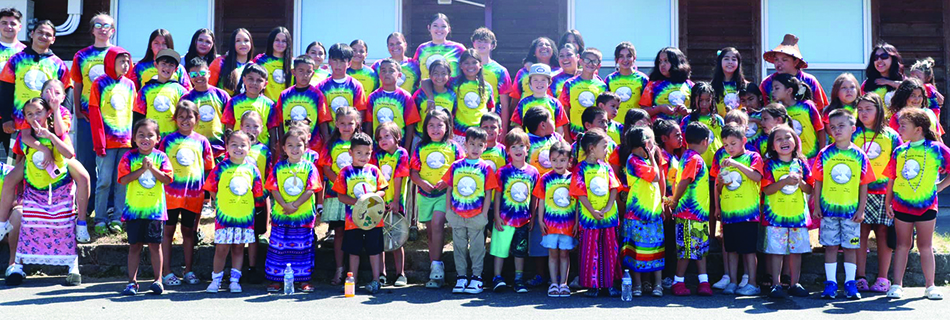
Wrapping up the 27th annual Lushootseed camp, one thing is sure: the kids will come and learn a bit about their culture, but the memories of being a part of the play and being with friends will last a lifetime.
Catching culture and community at Spee-Bi-Dah
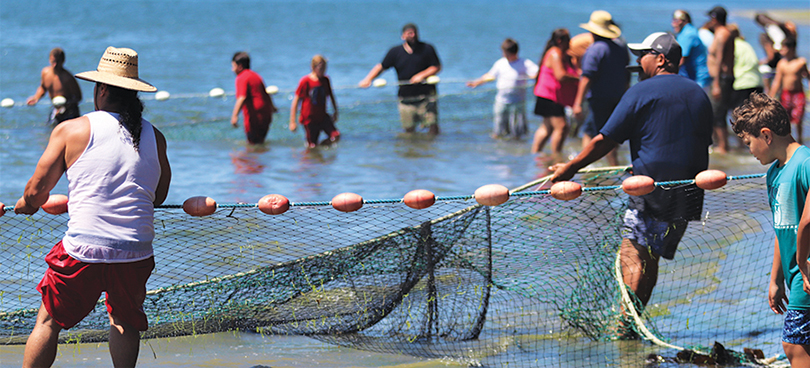
By Micheal Rios, Tulalip News
Event facilitators and support staff took to the calming, compact sand of Spee-Bi-Dah beach shortly after sunrise on Saturday, July 20. As they prepped the shoreline for hundreds of soon-to-be arriving guests, lifetime fishermen and current Tribal Councilman Glen Gobin captained his boat and crew as they made one large, sweeping arc after another along the coastline.
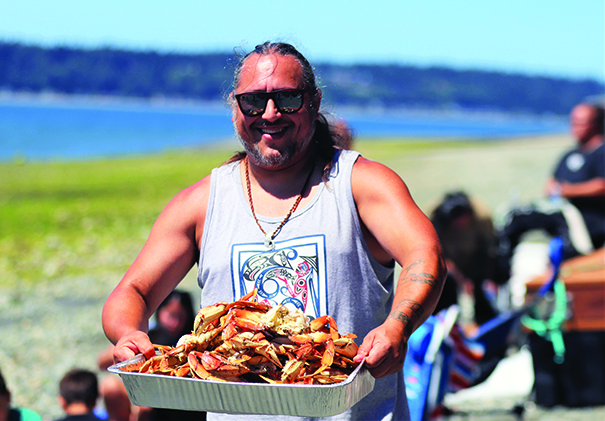
With each pass, their trailing net formed a visible horseshoe shape atop the water, which built anticipation and excitement among observers who wondered what kind of seafood bounty would soon reveal itself. Tulalip culture bearers of all ages and fishing experience were joined by local community members in a unified effort to pull in the jumbo-sized net from the ocean bank. When the net was nearly to the shore, Chinook salmon would alert their presence by splashing the shallow waters with their tails. Time and time again, the simple sound of fish tails breaking the Salish Sea would immediately lead to children screaming in absolute delight.

Only a matter of minutes later, the beach seined Chinook were expertly processed, carved into filets, smoked on the spot, and made readily available for exquisite consumption. These were the stunning scenes that laid the foundation for the always culture-fueled, community building seafood extravaganza that is Spee-Bi-Dah.
Captain Glen once described the annual beach seining event as “a lifetime of memories. This is how we used to fish all the time. Every year, I’m amazed at how many people come out to partake and enjoy the day. Spee-Bi-Dah really is a great community event. Like it was for our past generations, today is a shared community experience.”
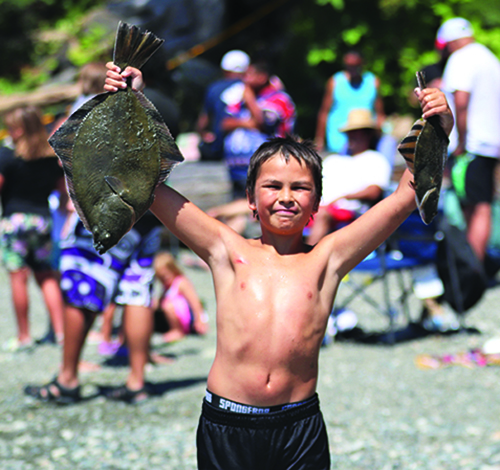
As the temperature soared into the upper 80s on the gorgeous summer day, so too did the sense of community and shared purpose alongside the especially meaningful stretch of Salish Sea shoreline.
“One of my favorite things is seeing all the babies play on the beach and in the water. Seeing their spirits so high on in these ancestral fishing grounds reminds me that our ancestors are here, too, and we are making them so proud by keeping the culture alive,” said Tulalip elder Lena Hammons shortly after witnessing her great-granddaughter Sevi enjoy some crab.
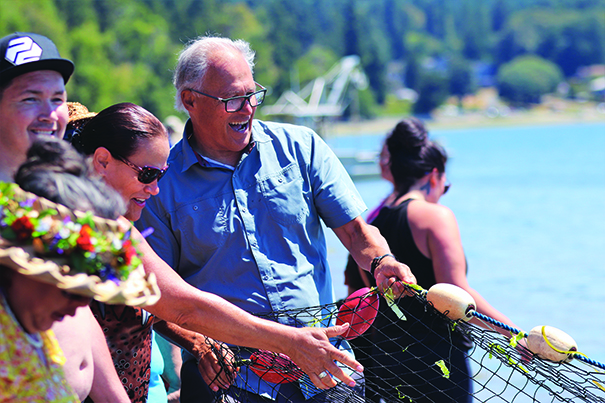
“The children pulling the net in and picking fish straight from the sea is a sight I’ll never tire of seeing. To me, that’s healing the community and healing the trauma inflicted upon our ancestors who weren’t allowed to be proud Tulalip people, especially those generations of children who were stripped of their culture during the Boarding School Era,” she continued. “Spee-Bi-Dah brings us all together for a good event that’s spiritually empowering. It’s just awesome to experience and grows bigger every year as our tribal membership continues to grow bigger.”
Indeed, with Tulalip membership now over 5,300 and showing no signs of slowing down, there are always blossoming families to be found immersing themselves in a tidal wave of Coast Salish culture at events like Spee-Bi-Dah. One such family seen sprawled out on the Spee-Bi-Dah sands, filling their bellies with a seafood feast were momma bear Stephanie Ancheta and her three boys Zaylen (11), Xavier (5), and Calvin Jr. (2).

Asked what’s their favorite seafood, Zaylen said crab before cracking open a crap leg, and Xavier said salmon while staring into the beady eyes of a shrimp that dwarfed his hand.
“I’ve so been looking forward to this day because I was unable to attend the last two years,” admitted Stephanie. “We’re having a lot of fun. It’s really cool to spend the day out here, eating good foods and running into people we know. It really is a special occasion to have all these delicious foods available to us. Salmon is something we have regular access to, but the crab, clams, and shrimp we don’t. For me, watching my boys try new foods and really take a liking to them is pretty cool.”

Among the many attendees were residents of the gated Spee-Bi-Dah housing community, which included a family of Chinese immigrants headed by patriarch Zhou Bailang. They shared how after immigrating to the U.S., they eventually settled in the Pacific Northwest because of the natural beauty, fantastic climate, and connection to the sea, specifically fish and fishing.
“My son and I share a passion for fishing. He gets so excited for this day because he gets to help pull the net in,” said Zhou while sitting in a shaded area with his family. “This is our biggest family gathering of the year. This year we flew in our parents from China so they could be here with us. It’s their very first time here.”
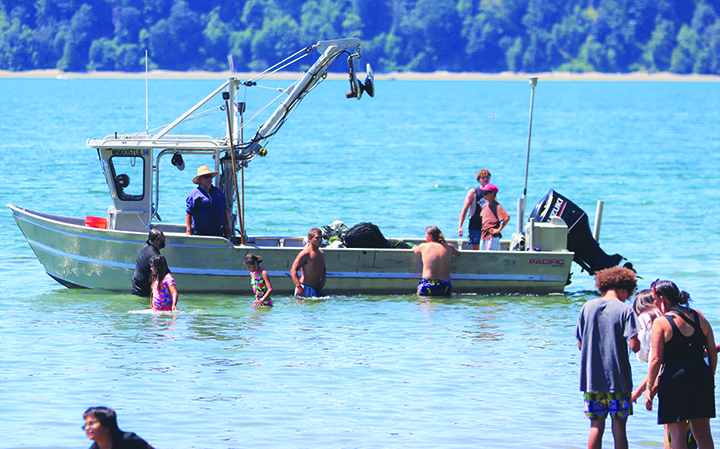
Epitomizing what it truly means to participate in a cultural exchange, Zhou and his son could be seen regularly helping to pull the net in. Zhou’s son even received some first-hand wisdom from Captain Glen that he later used when showing several Tulalip youth how to pull the net in as a team, instead of as individuals.
Over the day-long celebration of culture and community, hundreds and hundreds enthusiastic beach goers enjoyed the many sights, sounds, and delicious tastes that make the annual beach seine such a highly anticipated and coveted event. The freshest seafood-filled meals were enjoyed, while friends and families reminisced about old times.

Stories shared and memories made weren’t just confined to the Spee-Bi-Dah shores either. Just like years past, Tulalip implemented a shuttle system for most efficient transport to and from the event. One of the drivers responsible for shuttling individuals and families from their parked vehicles at the Gathering Hall to the beach was John Ordonia-Davis.
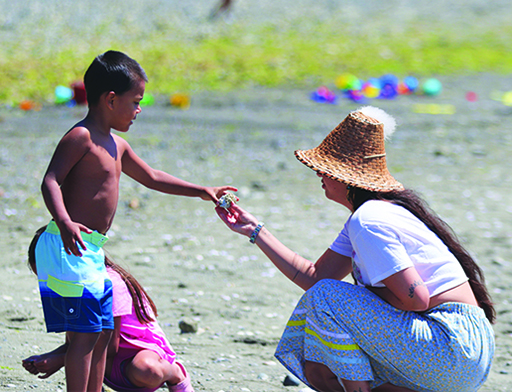
“I started shuttling support staff down to the beach at 6:00 a.m. and then all the individuals and families who started showing up around 9:00 a.m. We continue shuttling well into the evening, until the beach is clear.” explained John. “It’s always cool to hear people’s excitement while driving them down there and then to hear all about their experience when driving them back to the Gathering Hall. One particular story that stands out is this couple of first-time tribal members, older too, who told me how much they loved seeing so much family they haven’t seen in years. They were so happy the Tribe made this happen. Their big smiles and excitement in their voices is something I won’t forget.”
Surely, that story shared with John in the shuttle van is but one of a countless number that were retold that day by Spee-Bi-Dah attendees who were eager to share their experience with others. It’s those stories and the many shared photos that prove what was really caught in those beach seine nets wasn’t salmon, what was truly caught was culture and community.
Tulalip Youth Faith Iukes Honored with UNITY 25 Under 25 Award

Submitted by Faith Iukes
Tulalip, WA – Faith Iukes, a member of the Tulalip Tribes, has been recognized as one of the recipients of the prestigious UNITY 25 Under 25 Award. This national youth leadership recognition program celebrates the achievements of Native American and Alaskan Native youth who embody UNITY’s core mission of living a balanced life by developing their spiritual, mental, physical, and social well-being.
The award was presented during the annual UNITY Conference, held this year in Portland, Oregon. The conference brought together young leaders from across the nation to share their experiences, learn from each other, and celebrate their achievements. Faith not only attended the conference but also played an active role by hosting a workshop on vlogging and podcasting.
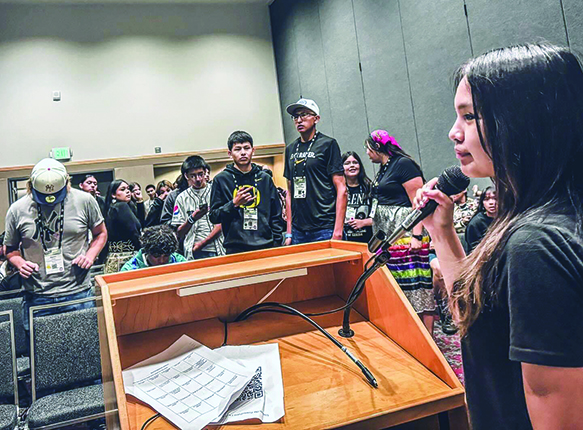
Faith’s workshop, titled “Intro to Vlogging and Podcasting,” drew an impressive 250 participants over two sessions. The workshop provided attendees with the tools and knowledge to start their own vlogs and podcasts, empowering them to share their stories and voices with a broader audience. Faith’s dedication to her community and her passion for media production were evident as she guided her peers through the basics of content creation.
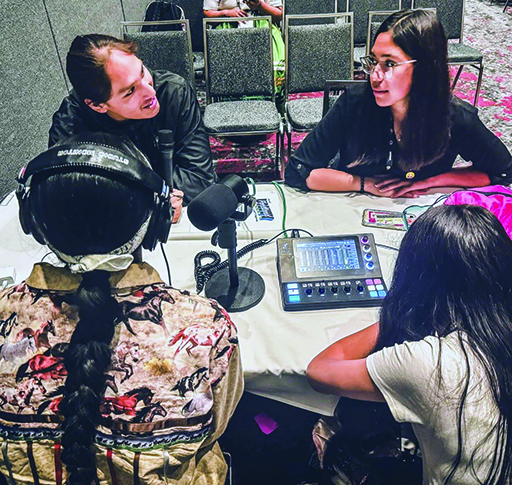
In addition to her workshop, Faith and other UNITY participants took part in a field day at Nike’s world headquarters, sponsored by the Nike N7 program. This event focused on learning about teamwork and culminated in watching the 3-on-3 UNITY basketball tournament. The field day provided a unique opportunity for the youth to engage in physical activities, build camaraderie, and witness the spirit of healthy competition.
“I am deeply honored to receive this award,” Faith said. “But I want to share this recognition with all the youth from Tulalip. We are all capable of achieving great things when we support each other and work together.”
Faith’s journey is a source of inspiration for many young people in her community. Her commitment to personal growth and her willingness to share her knowledge and skills with others exemplify the spirit of the UNITY 25 Under 25 Award.
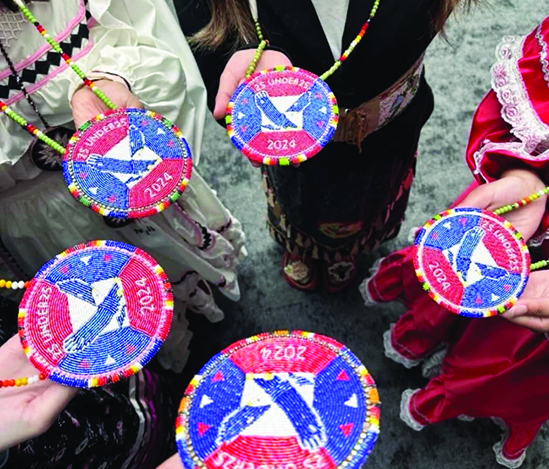
“This award isn’t just for me,” Faith added. “It’s for every young person in Tulalip who dreams of making a difference. We all have the potential to be leaders and to create positive change in our communities.”
Faith also dedicated her award to her great grandfather, Hank Williams, who has been a constant source of belief and support throughout her journey. “This award is for my grandpa Hank Williams for always believing in me and supporting me,” she shared, highlighting the importance of family and community in her achievements.

Faith’s recognition is a testament to the strength and resilience of Native youth. As she continues to pursue her passions and uplift her community, she serves as a role model for others to follow.
For more information on the UNITY 25 Under 25 Award and the annual UNITY Conference, visit (https://unityinc.org)
About UNITY
UNITY (United National Indian Tribal Youth) is a national organization dedicated to fostering the spiritual, mental, physical, and social well-being of Native American and Alaskan Native youth. Through its programs and initiatives, UNITY aims to empower young leaders to create positive change in their communities.
Tulalip teens share excitement for Youth Canoe Journey

By Kalvin Valdillez, Tulalip News
Grounded, at peace, one with the universe are a few phrases that come to mind when thinking of that special connection coastal Natives experience when out on the Salish Sea. But in addition to that, there’s also this strong sense of pride, knowing that you are traveling the same waters as your ancestors, using the same mode of transportation, singing family songs that have been passed down the generations, speaking your tribe’s traditional language, and sharing your teachings as you celebrate the culture with other tribal nations.
That connection is important to experience for tribal adolescents, especially at such a crucial point in their lives; a time of self-discovery, as many prepare to embark on a personal journey of establishing their own identity. It also gives them the opportunity to sharpen and showcase their leadership skills and learn how to carry themselves while representing their respective tribes. Which is why many were elated when Puyallup announced an inter-tribal pull this summer, specifically for the youth.
The 2024 youth canoe journey is officially underway, and currently there are dozens of canoes already on the water enroute to this year’s final destination at Puyallup. After visiting the neighboring tribes of Nooksack, Lummi, Samish, and Swinomish, the canoes will land at Tulalip this year on Saturday July 27.
Tulalip began preparations for canoe journey at the top of the year by hosting weekly culture nights, where attendees crafted regalia and various items that could be both utilized and gifted by the youth during the pull to Puyallup. This spring, Tulalip held an awakening ceremony for the tribal canoes, Big Brother, Big Sister, and Little Sister. Shortly after the awakening, the Tribe organized weekly canoe practices, providing the opportunity for participants to train and build endurance for long distance pulls across the sacred waterways.
During the final days leading up to the landing at Tulalip Bay, the Education Division is hosting culture week at the teen center, which is focused on fashioning last minute gear and regalia for this year’s journey. Multiple regalia stations are setup in the gym, where the kids can work on ribbon skirts, wool skirts, beadwork, drumsticks and more.
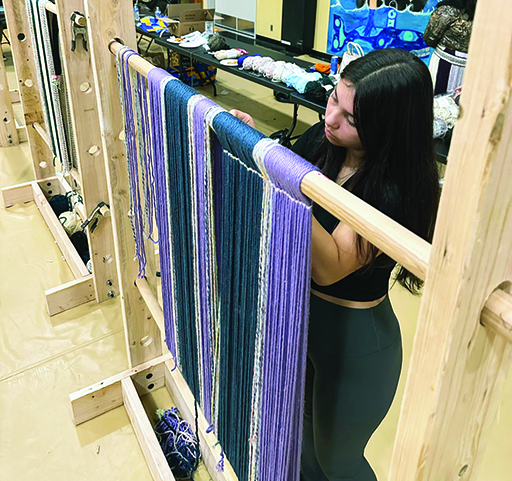
Shane McLean, Youth Council Advisor, shared, “From our department, we’re having four chaperones that will be taking twenty youths from the teen center. And then there are youth that the canoes families will be chaperoning themselves as well. I’m estimating that will be around thirty kids, so probably around fifty of our youth will be pulling this year. I’m excited to get our youth connected to the water, to the land. Giving them a chance to go out and sing and get healing, and hopefully gather teachings from different elders along the way.”
Throughout each day, the teens popped in and out of the gym to work on their projects, while still taking time to enjoy the weather outdoors with their friends. On the afternoon of July 23, Tulalip News was able to catch up with seven teens who were buzzing with anticipation as this year’s canoe journey rapidly approaches the shores of Tulalip Bay.
While on a leisurely stroll of the teen center campus, friends Kiannah Moses and Ellashawnee Gorhan Dumont spoke about what they are looking forward to the most during the 2024 journey.
After sharing that she had fun during the weekly canoe practices, Kiannah stated, “[Practice] was really fun and pretty cool. I’m looking forward to everything – hanging out with my family, paddling, and camping!”
Ellashawnee added, “I’m excited for the canoes to come in. Canoe Journey makes me happy and proud, it’s awesome to know your culture and just to feel that feeling of being out on the water.”
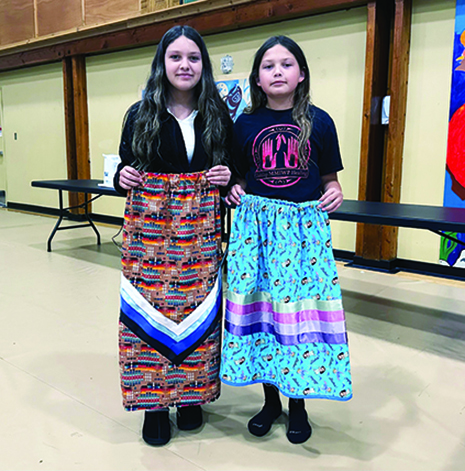
Madison Sheldon was also soaking up some sunshine and putting in some work at the skatepark when she took a moment to share, “I’m so hyped for canoe journeys because this year I get to paddle. Ever since I got to practice for the first time, I’ve had a connection with the canoes, Big Brother and Big Sister, and I felt so happy paddling with all the fam. I can’t wait for camping out with the family, I love doing that and hanging out with the cousins. I think it’s important to share some parts of our culture with other tribes because some kids don’t know our songs and we don’t know their songs, or what their tribe does and what other tribes do. And I like sharing anything about our tribe.”
Inside of the teen center, Taya Shopbell and Izzabella Jones, proudly held up their ribbon skirts for a photo. Taya shared that she is still thinking about venturing out on the canoe this year, but she is excited to sing and dance during protocol. And Izzabella echoed Taya’s sentiment and said, “It always feels nice to go dance and be a part of my culture. I’m looking forward to camping, going with my friends, and dancing.”
Over at the beading station, Kaidence Stricklin was hard at work, constructing a necklace of purple beads. Taking a quick break to chat with us she admitted, “I honestly don’t know what to expect, but I’m really excited because this is my first time. I’m mostly looking forward to staying up all night and watching protocol.”
Nakoyia Fryberg was beaming with pride as she put the finishing touches on her wool skirt when we caught up with her. She expressed, “I actually just now finished this skirt. And this is the one that I’m going to be wearing on journeys. It took me awhile. I’m looking forward to hearing everyone sing and seeing everyone dance. I think it’s really important to keep it going, so that when we’re not here anymore, it can keep going. We’re trying to ensure that this keeps going even after we’re gone. It’s about seven generations – thinking of the people who aren’t here yet and what we need to do to make sure that the teaching gets to those people.”
For more information about the 2024 youth paddle to Puyallup or Education Division’s culture week, please contact the teen center at (360) 716-4909.
The Tribe recently put out a request for volunteers for the canoe landing at Tulalip on July 27, from 8am – 8pm. Duties include handing out food/drinks, trash clean up, and dinner/table clean up. For additional details and to sign up to volunteer, please send an inquiry to krisanfryberg@tulaliptribes-nsn.gov.
Savage Sage takes first place at Huckfest competition

Submitted by Christina Parker, Tulalip tribal member
Our 11 year old son Sage Parker aka “Savage Sage” has been competing in the UTV Takeover events for a few years. In April, Sage was at a race competition and ended up having a pretty intense roll, he flipped 3 times and totaled his cage and caused other damage on his car. We had to scramble to get his car rebuilt for the UTV Takeover Event that he practices for year around that started June 25.

Thankfully we were successful in getting his car repaired and ready for the events. Sage competed in the “Huckfest” competition on June 29. There is not a youth class for Sage to compete in, so he’s competing against grown adults.
There were so many cars that showed up to compete, they were able to break the competition into two classes, one for cars with Turbo and a NA Class (non-turbo). All of his hard work paid off and Sage won 1st place in the non-turbo class and jumped 82 feet. The 2nd place winner in non turbo class got 64 feet.

I have a lot of videos of it from the inside of his car, outside of his car and my perspective of the video, it’s fantastic! Sage is the youngest in the history of this sport to compete and win this competition and we believe he’s the only Native American competing in this sport.
Sage is an athlete/ambassador with the UTV Takeover Team and has two more events for 2024. September 3thru September 8 at Winchester Bay Dunes in Oregon and October 15 thru October 20 at Sand Hollow State Park in Hurricane Utah.
July 20, 2024 syəcəb
Use the following link to download the July 20, 2024 issue of the syəcəb
Building community and wellness

By Wade Sheldon, Tulalip News
The day began at Camano Island State Park with a cool breeze and overcast skies. On Friday, July 12, the Tulalip Health Clinic held a day camp to educate patients and foster connections between them and their doctors. The camp focused on effective ways to manage or prevent diabetes. Guests left with not only knowledge but also healthy treats and organic oils.

Cultural bearer Matt Fryberg opened the event with song and prayer to a small
Doctors and specialists from the clinic introduced themselves and shared insights into their areas of expertise in diabetes management. Tips ranged from simple activities like walking to more complex tasks like monitoring blood sugar levels and eating the right foods.

“It was a beautiful day,” said Dr. Rhonda Nelson, Podiatrist. “It’s a sense of community and learning about shared interests. One good tip for the day from me, as a podiatrist, would be to get outside, walk, and enjoy the beautiful weather.”

Leahy explained the inspiration behind the day camp, noting its design to allow providers to interact with patients in a non-threatening environment. This approach helps patients feel more comfortable and better understand the advice given by their healthcare providers.

Barbara Brockway, a community member, shared her success story, crediting the program for helping her lower her A1C from 8.6 to 7.1 by learning to enjoy vegetables and eating better. “I think these events are great,” she said. “They bring a real sense of community and show that the organizers genuinely care about our health.”

Dr. Gary Ferguson, Director of Integrative Medicine, praised the food spread, which included many traditional dishes beneficial for diabetes management. He encouraged continued support for local diabetes prevention programs and announced more classes in the fall.
If you or someone you know would like to learn more about managing or preventing diabetes, contact Veronica Leahy at vleahy@tulaliptribes-nsn.gov for more information.
Golfing fore a cause: Leah’s Dream Foundation celebrates 10th annual Golf Tournament

By Kalvin Valdillez, Tulalip News
It was a gorgeous sunny day on July 13, and the clear blue skies accentuated the vibrant colors of the fairways and greens of the Battle Creek Golf Course. Over 100 golfers tee’d off for a great cause that afternoon to help raise funds and highlight the efforts of a local nonprofit, Leah’s Dream Foundation.
Established in 2015, Leah’s Dream has made a huge impact for the special needs children and young adults of Tulalip and Marysville over the years. Through their work, they have built up a strong community for the kids and their families, resulting in many lifelong friendships, core memories filled with entertaining activities and events, and countless smiles as the kids are afforded the opportunity to simply enjoy being their selves in a safe and fun environment.

Leah’s Dream hosts bi-monthly activity nights, which are a big hit and something their families always look forward to. Leah’s Dream Foundation is a major advocate for inclusion for the students with special needs who attend the Marysville School District. The foundation utilizes their funds to provide supplies, learning tools, snacks, and curriculum for the special needs classrooms within MSD. During the 22-23 school year, the nonprofit also provided funds for sensory playground equipment, that is wheelchair accessible, at the Grove and Marshall elementary schools. And recently, the foundation established an activity club, where karaoke reigns supreme during their get togethers.
The majority, if not all, of the funds used for activity nights, school supplies, and their famous Christmastime gathering, are raised at the foundation’s annual golf tournament. Though it is their one and only fundraiser, the golf tournament continues to grow in popularity each year and generates donations in the thousands. From the sponsors to the golfers, and we can’t leave out the volunteers from the Marysville Getchell Native American and Friends Club, everyone chips in to make this summertime event a hole-in-one. And that of course includes the foundation’s namesake and star of the course, Leah Stacy.
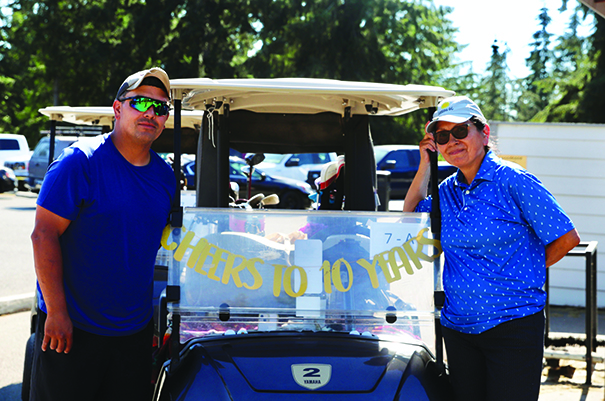
Leah, who is diagnosed with apraxia, was just a toddler when the first tournament was held in 2014, and throughout the years, she has been very hands-on in preparing for the annual fundraiser. From the first to the eighteenth hole, there were yard signs placed alongside the tee boxes and greens, that displayed the names of each sponsor. Every year, Leah looks forward to riding in the golf cart with her parents and personally placing the signs all throughout the course.
Leah’s mom and the nonprofit’s founder, Deanna Sheldon, shared, “Every single sign she puts out, she’s running across the course and standing by it with a permanent smile. She gets so pumped up! She loves Battle Creek so much because she’s been around it since she was very little – we come from a family of golfers, my dad goes out here every single day, my husband is the head pro here at Battle Creek, my nephews golf, I used to golf. And it’s been so great because we have so many people who participate and volunteer, who come every year and have seen her grow up. And they’re always amazed because she was four when we first started it and now, she’s fourteen.”
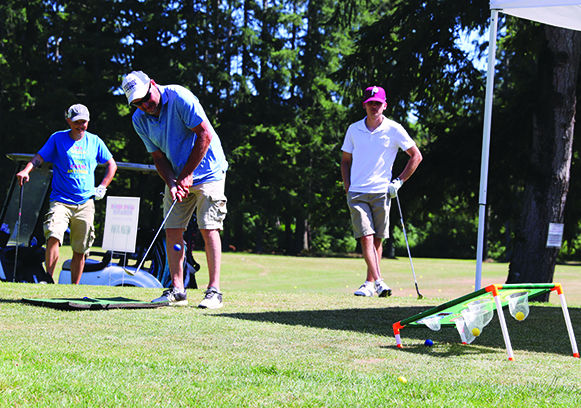
In addition to the main competition, the tournament also features a number of mini games at select tee boxes where golfers can try their luck, for a small donation, for various prizes. This year, Deanna worked a mini game station, at hole 3, where she was able to connect with the golfers and share in detail about Leah’s Dream Foundation. Upon learning more about the nonprofit, one golfer donated $1000 on the spot, through the Venmo app. Deanna also witnessed history, as the very first Leah’s Dream Foundation hole-in-one shot occurred at hole 3 this year.
The event also features a silent auction, and several themed gift baskets go up for bid. This year, the baskets included items such as golf attire, official Leah’s Dream Foundation branded gear, snacks, dog toys/treats, wine, and a nights stay at Angel of the Winds.

All told, with the help of 63 sponsors, 136 golfers, and numerous volunteers, the 10th annual Leah’s Dream Foundation Golf Tournament raised a record breaking $51,000.
Said Deanna, “It was a very successful tournament. We had a total of 34 teams. Our sponsorships were really great this year. I ran the final numbers, and we raised over $51,000! It was a great way to celebrate 10 years. Our very first tournament, we had only 60 people sign up. Five years ago, we were excited when we had 100 players. It just really shows how far we’ve come, from raising $12,000 to now, it shows the importance in what we do.
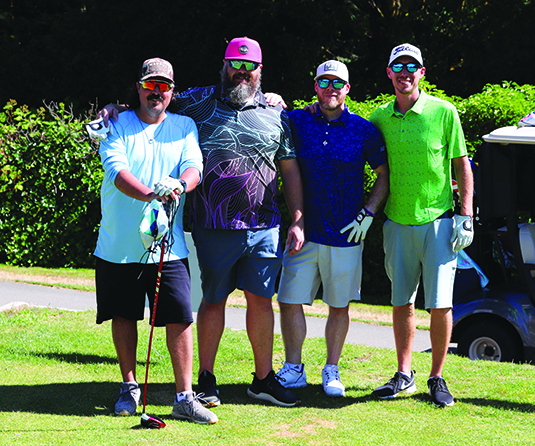
“When we first started off, we just wanted to make a small impact, we never thought we were going to raise a lot of money. But as the years have gone on, I feel that in so many ways, by being able to give back to the community through our events and outreach, and our ability to raise awareness about autism and the special needs community, it shows everyone the importance of supporting each individual. The classroom feedback we got this year was great, we got cards from students and teachers saying how good it feels that they are being thought of. And we’re just happy that we’re able to do a lot more now. Because we are able to raise more money, we’re able to give back more than we were able to in the past. It’s a great accomplishment for a small nonprofit and it makes such an impact knowing that all the money goes to areas that are well-needed.”
To make a monetary donation, volunteer your personal time, or to simply learn more information about the nonprofit organization, you can visit their official site, www.LeahsDream.org. And to stay up to date on all of their ongoing events and activities, be sure to follow their two Facebook pages, Leah’s Dream Foundation and Leah’s Dream Activity Club.
Traditions alive at language camp
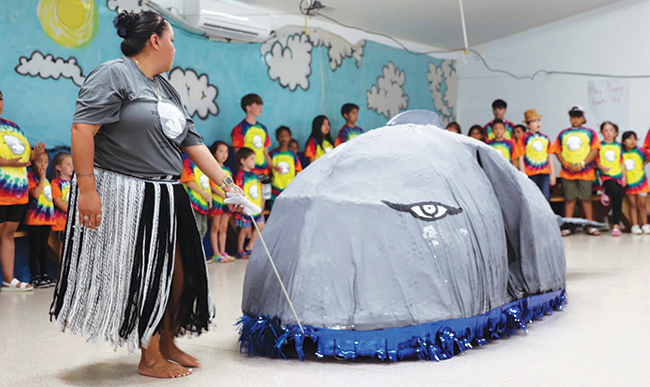
By Wade Sheldon, Tulalip News
The 27th annual Tulalip Lushootseed Day Camp hosted two, five-day sessions from July 8 to July 19. Kids were entrenched in a week-long immersion in the Lushootseed language and traditional teachings, with the first week concluding on Friday, July 12 at the Kenny Moses Building. During camp, the youth rehearse a play based on a traditional Tulalip story. The play is then performed for the community during the closing ceremony on the last day of camp.
The children are immersed in various activities throughout the week. Each morning began with an opening circle, where they learned what was expected of them throughout the day. They explored woodworking, created stories through beautiful watercolor paintings, and enjoyed games like Lushootseed jeopardy and bingo. Outside, the kids had a blast with activities like a fishing game, whale games, and more. In the traditional teachings workshop, they crafted story poles and charm bracelets. The kids also helped weave a wool skirt and shawl for the giveaway, when these handmade crafts are gifted to audience members.
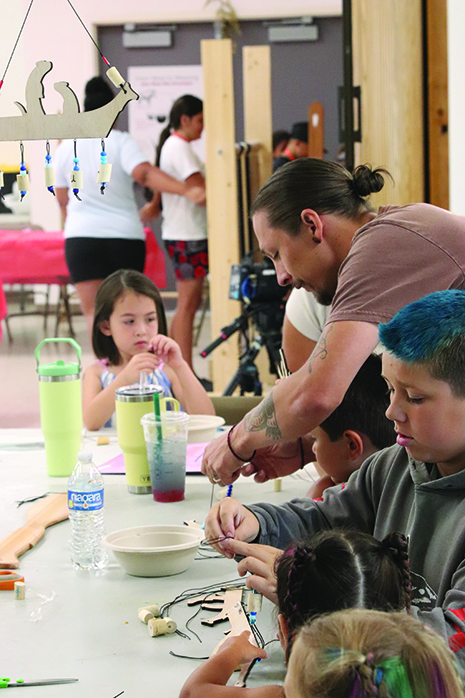
By the end of the week, the kids were ready to perform play of Little Mink and Younger Cousin, Tetyika, a traditional story told by Tulalip legend Edward Hagan Sam. The late David Spencer Sr. illustrated and translated it for the Language department to use. His artwork was showcased on the front of the shirts the kids wore on the day of the play and on the backdrop scene.

This story is a way back to our old customs, and reinvigorating these historical stories for the youth enriches our heritage. These stories help the youth by letting each person take from the story their own interpretation.
Natosha Gobin, Language Department Manager, said, “We look forward to this the most every year because it is the time when our staff gets to be in the same building doing the same work. Otherwise, we are split up into different schools and different classrooms. It’s nice to be here working with the kids.”
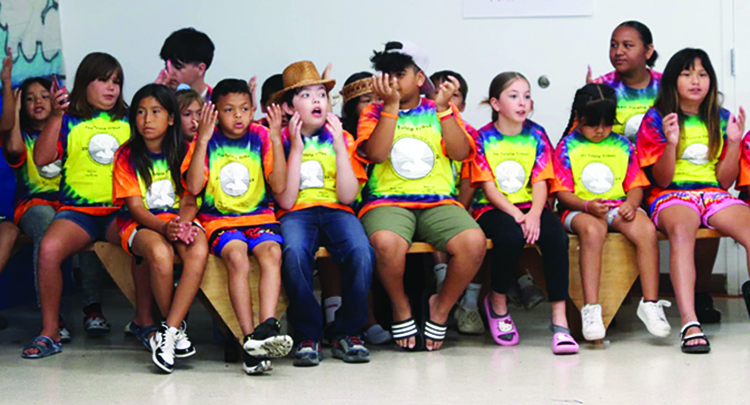

A couple of camp participants shared their favorite part of the Lushootseed camp. Chiefy Williams said, “It was pretty good. I liked doing the play.” Another student who enjoyed the camp, Francis, said, “I liked woodworking; I made some paddles and windchimes. My favorite part was singing about the whale going to the beach.”
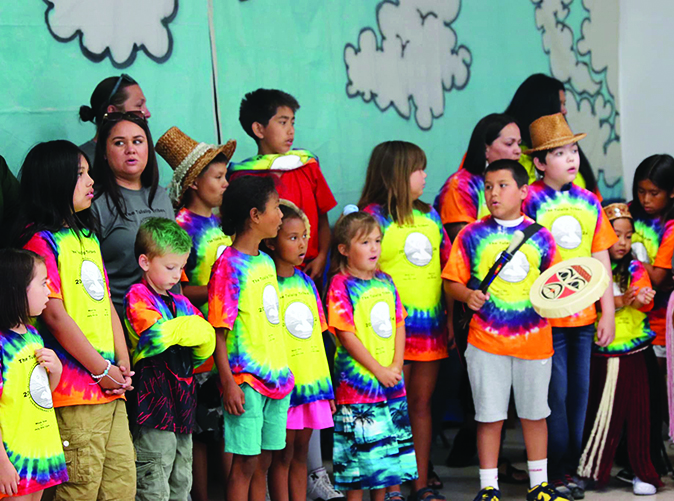
At the Lushootseed Day Camp, participants gain valuable skills and develop a strong connection to their cultural heritage, creating lasting memories for all involved. To learn more about the traditional Lushootseed language, we encourage you to visit tulaliplushootseed.com.